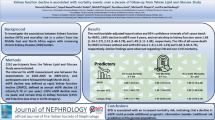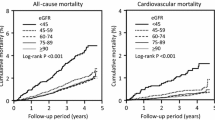Abstract
Background
Chronic kidney disease is a global health problem that is closely related to the aging population. Although plasma glucose levels have been shown to be related to renal dysfunction, risk factors for renal functional impairment in the geriatric population are unknown. The authors therefore aimed to investigate the determinants of renal functional impairment in an elderly population.
Methods
From June 2014 to August 2015, 912 participants (aged > 65 years) were recruited. Renal function was assessed at baseline; follow-up was conducted in 2016. Within the framework of comprehensive cardiovascular examinations, all conventional cardiovascular risk factors, fasting plasma glucose (FPG), and renal function were assessed. Renal function was evaluated by the estimated glomerular filtration rate (e-GFR) using a modified Modification of Diet in Renal Disease formula. Rapid decline in e-GFR was defined as an e-GFR slope > 5 mL/min per 1.73 m2 per year.
Results
We observed that FPG levels were significantly higher in participants with (6.15 ± 2.76 mmol/L) than in those without (5.56 ± 1.61 mmol/L) a rapid decline in e-GFR (p = 0.02). The average decline in e-GFR was 0.149 mL/min/1.73m2 per year in this elderly population, and the increasing risk of having rapid decline in e-GFR was 0.44-fold each year. In the full adjustment model, decline in e-GFR (p = 0.02) and rapid decline in e-GFR (OR1.33, 95% CI 1.03–1.72) were significantly associated with FPG, independent of other conventional cardiovascular risk factors. Using the same models, decline in e-GFR (p = 0.04) and rapid decline in e-GFR (OR 1.57, 95% CI 1.05–2.35) were also significantly associated with FPG in diabetic population, but they were not in non-diabetic population.
Conclusions
In community-dwelling elderly Chinese, the average decline in e-GFR was 0.149 mL/min/1.73m2 per year. FPG control is important for delaying renal functional impairment in elderly population.
Trial registration NSS, NCT02368938
Similar content being viewed by others
References
Zhang L, Wang F, Wang L et al (2012) Prevalence of chronic kidney disease in China: a cross-sectional survey. Lancet 379:815–822. https://doi.org/10.1016/S0140-6736(12)60033-6
Tsukamoto Y, Wang H, Becker G et al (2009) Report of the Asian Forum of Chronic Kidney Disease Initiative (AFCKDI) 2007. "Current status and perspective of CKD in Asia": diversity and specificity among Asian countries. Clin Exp Nephrol 13:249–56. https://doi.org/10.1007/s10157-009-0156-8
Komici K, Femminella GD, de Lucia C et al (2019) Predisposing factors to heart failure in diabetic nephropathy: a look at the sympathetic nervous system hyperactivity. Aging Clin Exp Res 31:321–330. https://doi.org/10.1007/s40520-018-0973-2
Go AS, Chertow GM, Fan D et al (2004) Chronic kidney disease and the risks of death, cardiovascular events, and hospitalization. N Engl J Med 351:1296–1305. https://doi.org/10.1056/NEJMoa041031
Hinderliter A, Padilla RL, Gillespie BW et al (2015) Association of carotid intima-media thickness with cardiovascular risk factors and patient outcomes in advanced chronic kidney disease: the RRI-CKD study. Clin Nephrol 84:10–20. https://doi.org/10.5414/CN108494
Group DER, de Boer IH, Sun W et al (2011) Intensive diabetes therapy and glomerular filtration rate in type 1 diabetes. N Engl J Med 365:2366–76. https://doi.org/10.1056/NEJMoa1111732
Palatini P, Mormino P, Dorigatti F et al (2006) Glomerular hyperfiltration predicts the development of microalbuminuria in stage 1 hypertension: the HARVEST. Kidney Int 70:578–584. https://doi.org/10.1038/sj.ki.5001603
Gerchman F, Tong J, Utzschneider KM et al (2009) Body mass index is associated with increased creatinine clearance by a mechanism independent of body fat distribution. J Clin Endocrinol Metab 94:3781–3788. https://doi.org/10.1210/jc.2008-2508
Pruijm M, Wuerzner G, Maillard M et al (2010) Glomerular hyperfiltration and increased proximal sodium reabsorption in subjects with type 2 diabetes or impaired fasting glucose in a population of the African region. Nephrol Dial Transplant 25:2225–2231. https://doi.org/10.1093/ndt/gfq008
Brenner BM, Lawler EV, Mackenzie HS (1996) The hyperfiltration theory: a paradigm shift in nephrology. Kidney Int 49:1774–1777
Melsom T, Mathisen UD, Ingebretsen OC et al (2011) Impaired fasting glucose is associated with renal hyperfiltration in the general population. Diabetes Care 34:1546–1551. https://doi.org/10.2337/dc11-0235
Koulouridis E, Georgalidis K, Kostimpa I et al (2010) Metabolic syndrome risk factors and estimated glomerular filtration rate among children and adolescents. Pediatr Nephrol 25:491–498. https://doi.org/10.1007/s00467-009-1364-x
Tomaszewski M, Charchar FJ, Maric C et al (2007) Glomerular hyperfiltration: a new marker of metabolic risk. Kidney Int 71:816–821. https://doi.org/10.1038/sj.ki.5002160
Hermans MM, Henry R, Dekker JM et al (2007) Estimated glomerular filtration rate and urinary albumin excretion are independently associated with greater arterial stiffness: the Hoorn Study. J Am Soc Nephrol 18:1942–1952. https://doi.org/10.1681/ASN.2006111217
Campbell NG, Varagunam M, Sawhney V et al (2012) Mild chronic kidney disease is an independent predictor of long-term mortality after emergency angiography and primary percutaneous intervention in patients with ST-elevation myocardial infarction. Heart 98:42–47. https://doi.org/10.1136/heartjnl-2011-300024
Budoff MJ, Rader DJ, Reilly MP et al (2011) Relationship of estimated GFR and coronary artery calcification in the CRIC (Chronic Renal Insufficiency Cohort) Study. Am J Kidney Dis 58:519–526. https://doi.org/10.1053/j.ajkd.2011.04.024
Wang C, Song J, Sun Y et al (2014) Blood glucose is associated with chronic kidney disease in subjects with impaired glucose tolerance, but not in those with impaired fasting glucose. J Diabetes 6:574–576. https://doi.org/10.1111/1753-0407.12174
Ji B, Zhang S, Gong L et al (2013) The risk factors of mild decline in estimated glomerular filtration rate in a community-based population. Clin Biochem 46:750–754. https://doi.org/10.1016/j.clinbiochem.2013.01.011
Browne GM, Eustace JA, Fitzgerald AP et al (2012) Prevalence of diminished kidney function in a representative sample of middle and older age adults in the Irish population. BMC Nephrol 13:144. https://doi.org/10.1186/1471-2369-13-144
Vart P, Gansevoort RT, Coresh J et al (2013) Socioeconomic measures and CKD in the United States and The Netherlands. Clin J Am Soc Nephrol 8:1685–1693. https://doi.org/10.2215/CJN.12521212
Arora P, Vasa P, Brenner D et al (2013) Prevalence estimates of chronic kidney disease in Canada: results of a nationally representative survey. CMAJ 185:E417–E423. https://doi.org/10.1503/cmaj.120833
Ungar A, Iacomelli I, Giordano A et al (2015) Evaluation of renal function in the elderly, not as easy as it seems: a review. Aging Clin Exp Res 27:397–401. https://doi.org/10.1007/s40520-014-0311-2
Anpalahan M, Savvas S, Lo KY et al (2017) Chronic idiopathic normocytic anaemia in older people: the risk factors and the role of age-associated renal impairment. Aging Clin Exp Res 29:147–155. https://doi.org/10.1007/s40520-016-0563-0
Poggio ED, Rule AD (2009) A critical evaluation of chronic kidney disease–should isolated reduced estimated glomerular filtration rate be considered a 'disease'? Nephrol Dial Transplant 24:698–700. https://doi.org/10.1093/ndt/gfn704
Carter JL, Stevens PE, Irving JE et al (2011) Estimating glomerular filtration rate: comparison of the CKD-EPI and MDRD equations in a large UK cohort with particular emphasis on the effect of age. QJM 104:839–847. https://doi.org/10.1093/qjmed/hcr077
Diabetes Control and Complications Trial Research Group, Nathan DM et al (1993) The effect of intensive treatment of diabetes on the development and progression of long-term complications in insulin-dependent diabetes mellitus. N Engl J Med 329:977–86. https://doi.org/10.1056/NEJM199309303291401
Miyakoshi T, Nakasone Y, Sato Y et al (2017) Primacy of lowered baseline glomerular filtration rate as a risk for incident chronic kidney disease: A longitudinal study in Japanese subjects. Nephrology (Carlton) 22:684–689. https://doi.org/10.1111/nep.12836
Koshi T, Sagesaka H, Sato Y et al (2018) Elevated haemoglobin A1c but not fasting plasma glucose conveys risk of chronic kidney disease in non-diabetic individuals. Diabetes Res Clin Pract 146:233–239. https://doi.org/10.1016/j.diabres.2018.10.026
Hsu CY, Huang PH, Chen TH et al (2016) Increased circulating visfatin is associated with progression of kidney disease in non-diabetic hypertensive patients. Am J Hypertens 29:528–536. https://doi.org/10.1093/ajh/hpv132
Coutinho M, Gerstein HC, Wang Y et al (1999) The relationship between glucose and incident cardiovascular events. A metaregression analysis of published data from 20 studies of 95,783 individuals followed for 12.4 years. Diabetes Care 22:233–40. https://doi.org/10.2337/diacare.22.2.233
Lawes CM, Parag V, Bennett DA et al (2004) Blood glucose and risk of cardiovascular disease in the Asia Pacific region. Diabetes Care 27:2836–2842. https://doi.org/10.2337/diacare.27.12.2836
C Emerging Risk Factors, Sarwar N, Gao P et al (2010) Diabetes mellitus, fasting blood glucose concentration, and risk of vascular disease: a collaborative meta-analysis of 102 prospective studies. Lancet 375:2215–2222. https://doi.org/10.1016/S0140-6736(10)60484-9
Sung J, Song YM, Ebrahim S et al (2009) Fasting blood glucose and the risk of stroke and myocardial infarction. Circulation 119:812–819. https://doi.org/10.1161/CIRCULATIONAHA.108.776989
Funding
This study was authorized and financially supported by the Shanghai Municipal Government (15GWZK1002) and the National Key Technology R&D Program during the Thirteenth Five-year Plan Period (2017YFC0111800). Dr. Yi Zhang was supported by the National Nature Science Foundation of China (81670377) and the Shanghai Excellent Young Scholars Program (2017YQ065).
Author information
Authors and Affiliations
Contributions
XF and JT have contributed equally to this work. XF wrote the manuscript. JT designed the study. CC provided purely technical help. JX and MZ collated data. YL revised the manuscript. YX and YZ acquired the funding.
Corresponding authors
Ethics declarations
Conflict of interest
The authors declared they do not have anything to disclose regarding conflict of interest with respect to this manuscript.
Ethical approval
This study acquired approval of the Ethics Committee of Shanghai Tenth People’s Hospital. All procedures were performed in accordance with ethical standards. The registration ID on Clinical Trial is NCT02368938 (ClinicalTrials.gov).
Statement of human and animal rights
All procedures performed in studies involving human participants were in accordance with the ethical standards of the institutional and/or national research committee and with the 1964 Helsinki declaration and its later amendments or comparable ethical standards.
Informed consent
Written informed consent was obtained from all participants.
Additional information
Publisher's Note
Springer Nature remains neutral with regard to jurisdictional claims in published maps and institutional affiliations.
Rights and permissions
About this article
Cite this article
Fan, X., Teliewubai, J., Xiong, J. et al. Renal functional impairment in the elderly, the importance of fasting plasma glucose: the Northern Shanghai Study. Aging Clin Exp Res 33, 353–360 (2021). https://doi.org/10.1007/s40520-020-01527-x
Received:
Accepted:
Published:
Issue Date:
DOI: https://doi.org/10.1007/s40520-020-01527-x




